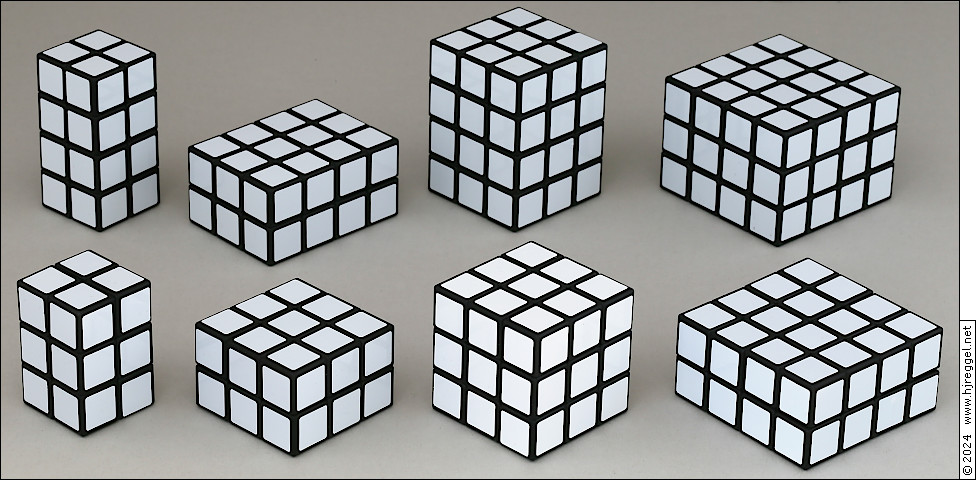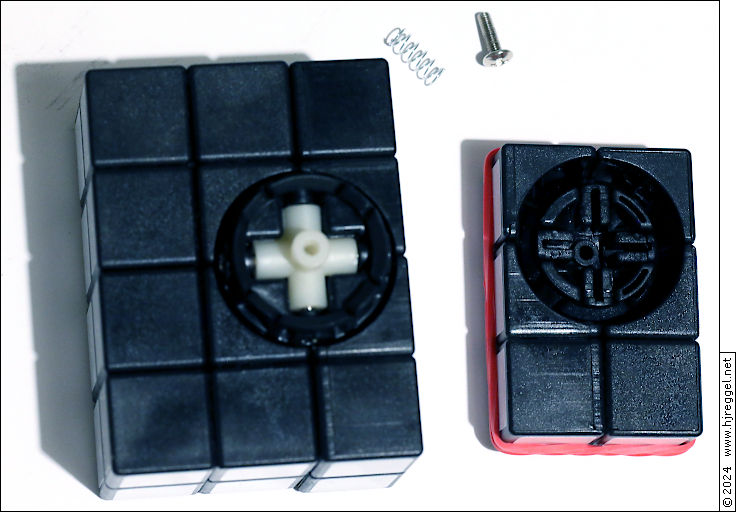 | |
| The Blanker Family | |
The Blanker Cube · The Blanker Family · Assembly · Gallery
The Original Blanker Cube is a simple shapemod of a 2×2×2 cube by extending it by one layer of cubies at three adjacent faces. This creates the effect of being a 3×3×3 Cube.
The modification uses four different types of cubies: 1×1×1, 1×1×2, 2×2×1 and 2×2×2. The mechanism is based on a 3×3×3 ball core with three blocked edge pieces. This allows mixing the different corner pieces is any way, without mechanical restrictions.
 | |
| The Blanker Family | |
The four different types of cubies allow different cubic and cuboid arrangements.
Please note that a 2×2×2 cube has no permutation constraints, but still has orientation constraints. If there is at least one symmetric corner piece, any corner orientation is possible. If there is no symmetric corner piece, the overall count of corner twists must be a multiple of three.
| Variant | Volume | 1×1×1 | 1×1×2 | 2×2×1 | 2×2×2 | Notes |
|---|---|---|---|---|---|---|
| 3×3×3 | 27 | 1 | 3 | 3 | 1 | original 3×3×3 Blanker Cube |
| 2×2×2 | 8 | 8 | no shape change | |||
| 2×2×3 | 12 | 4 | 4 | |||
| 2×2×4 | 16 | 8 | orientation constraint | |||
| 3×3×2 | 18 | 2 | 4 | 2 | ||
| 2×3×4 | 24 | 4 | 4 | orientation constraint | ||
| 3×3×4 | 36 | 2 | 4 | 2 | ||
| 4×4×2 | 32 | 8 | orientation constraint | |||
| 4×4×3 | 48 | 4 | 4 | |||
| 4×4×4 | 64 | 8 | no shape change |
The number of pieces for the seven non-trivial variants add up to six of each of the cubic cubies, and 22 of each of the irregular cubies. This means that you need eight Blanker Cubes to create the seven non-trivial variants. With the remaining eight pieces, two of each kind, you can't create a regular shape, so you end up with either some spare parts, or a Blankenstein Cube .
 | |
| Blanker Cube Assembly Setup | |
As mentioned before, the mechanism is based on a 3×3×3 ball core with three blocked edge pieces. All of the Blanker Cubes I disassembled had the 2×2×2 corner piece blocked. For easier assembly, a center piece not adjacent to the blocked piece should be removed. Be careful to prevent the screw and spring from popping across the room.
Disassembly is fairly easy, just peel off all of the loose parts. One corner piece and three edge pieces will stay attached to the ball core. The three edge pieces are blocked by tabs on the center cross. You should now have removed a screw, a spring, a center plate, seven corner pieces, and nine edge pieces from the core.
The following steps worked best for me to assemble a cube.
Now you can enjoy your Blanker Cuboid. Once you are familiar with the steps, assembly is a ten-minute job, or even less.
Note: The photo shows the assembly of the remaining eight pieces not making a proper Cuboid, but a "Blankenstein Cube" instead.
Blankenstein · Space Invaders · Blankoid meets Cuboid
If you build the seven Blanker Cuboids from eight Blanker Cubes, there are eight pieces left. You can either leave them as spare parts, or build one odd Blanker Cube.
 | |
| "Blankenstein" - The Eight Remaining Pieces | |
There is a simple pattern for a 3×3×3 Blanker Cube that looks like one of the attackers in the Arcade Video Game "Space Invaders". The same scheme can be applied to the 3×3×2 and 3×3×4 Blanker Cuboids.
 | |
| Space Invaders - The same silhouette with 3×3×4, 3×3×3 and 3×3×2 Blanker Cuboids and Cube | |
Although the mechanisms are different, these two Cuboids can share some common poses.
 | |
| Blankoid meets Cuboid - Left: 2×3×4 Blankoid, Right: 2×3×4 Cuboid | |
Top · The Blanker Cube · The Blanker Family · Assembly · Gallery
funCUBING Index Page · funCUBING Projects